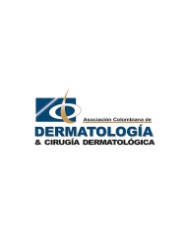Fotocarcinogénesis: un enfoque práctico
Palabras clave:
fotocarcinogénesis, cáncer cutáneo, radiación ultravioletaResumen
El cáncer es el resultado de una alteración en el ciclo celular dada por un desequilibrio entre oncogenes y genes supresores. Por esto ahora la biología molecular es el diagnóstico del presente y el tratamiento del futuro. La radiación ultravioleta es uno de los principales cofactores en la generación del cáncer cutáneo, en especial el carcinoma escamocelular, que se origina luego de exposiciones solares crónicas. En el carcinoma basocelular y en el melanoma el patrón de exposición solar intermitente es el más relacionado, pero para su desarrollo priman las características genéticas y el tipo de piel . Se describen las bases moleculares de los tres principales cánceres de piel y su relación con la radiación ultravioleta.
Biografía del autor/a
Adriana R. Cruz A., Universidad del Valle
RIII Dermatología. Universidad del Valle, Cali
Carolina Isaza de L., Universidad del Valle
Docente Departamento de Citogenética Universidad del Valle, Cali.
Referencias bibliográficas
2. Knudson A. Mutation and cancer: a statistical study. Proc Natl Acad Sci USA 1971; 68: 820-823
https://doi.org/10.1073/pnas.68.4.820
3. Tsao H. Update on familia! cancer syndromes and the skin. J Am Acad Dermatol 2000; 42: 939-969.
https://doi.org/10.1067/mjd.2000.104681
4. Kripke ML. Carcinogenesis: Ultraviolet Radiation. En: Fitzpatrick T, Eisen A, Wolff K, Freedberg 1, et al. Dermatology in General Medicine. New York, McGraw-Hill. 1999: 465-472.
5. Jhappan C, Noonan FP, Merlino G. Ultraviolet radiation and cutaneous malignant melanoma. Oncogene 2003;22:3099-3112.
https://doi.org/10.1038/sj.onc.1206450
6. Wang SO, Setlow R, Berxick M, et al. Ultraviolet A and melanoma: A review. J Am Acad Dermatol 2001; 44: 837- 846.
https://doi.org/10.1067/mjd.2001.114594
7. Ananthaswamy HN, Kripke ML. Mechanisms of ultraviolet radiation: carcinogenesis and immunesuppression. Miller SJ, Maloney ME. Cutaneous Oncology . Blackwell Science 1998; 14: 115-120.
8. Duthie MS, Kimber 1, Norval M. The effects of ultraviolet radiation on the human immune system. Br J Dermatol 1999; 140: 995-1009.
https://doi.org/10.1046/j.1365-2133.1999.02898.x
9. Yoshikawa T, Rae V, Bruins Solt W, et al. Susceptibility to effects of UVB radiation on induction of contact hypersensitivity as a risk factor for skin cancer in humans. J lnvest Dermatol 1990; 95: 530-536.
https://doi.org/10.1111/1523-1747.ep12504877
10. Hersey P, Haran G, Hasic E, et al. Alteration of T cel subsets and induction of suppressor T cell activity in normal subjects after exposure to sunlight. J lmmunol 1983; 31 :171-174,
11. Hersey P, Magrath H, Wilkinson F. Development of an in vitro system for the analysis of ultraviolet radiation induced suppression of natural killer cell activity. Photoche, Photobiol 1993; 57: 279-284.
https://doi.org/10.1111/j.1751-1097.1993.tb02287.x
12. Berwik M. Patterns of sun exposure which are causal for melanoma. Melanoma Crit Debates 2002; 1 :3-15.
https://doi.org/10.1002/9780470987346.ch1
13. Ortonne JP. From actinic keratosis to squamous cell carcinoma. Br J Dermatol 2002; 146: 20-23.
https://doi.org/10.1046/j.1365-2133.146.s61.6.x
14. Dodson JM, DeSpain J, Hewett JE. Malignan! potential of actinic keratoses and the controversy over treatment: a palien! oriented perspective. Arch Dermatol 1991; 127: 1029-1031.
https://doi.org/10.1001/archderm.1991.01680060103013
15. Rosso S, Zanetti R, Martinez C, et al. The multicentre south European study 'Helios' 11, different sun exposure patterns in the aetiology of basal cell and squamous cell carcinomas of the skin. Br J Cancer 1996; 73:1447-1454.
https://doi.org/10.1038/bjc.1996.275
16. Nomura T, Nakajima H, Hongyo T, et al. lnduction of cancer, actinic keratosis and specific p53 mutations by UV-B light in human skin maintained in severe combined immunodeficient mice. Cancer Res 1997; 57: 2081-2084.
17. Li G, Ho V, Berean K, et al. Ultraviolet radiation induction of squamous cell carcinomas in p53 transgenic mice. Cancer Res 1995; 55: 2070-2074.
18. Thompson se, Jolley D, Marks R. Reduction of solar keratoses by regular sunscreen use. N Engl J Med 1993; 329:1147-1151.
https://doi.org/10.1056/NEJM199310143291602
19. Norgauer J, ldzko M, Panther E, et al. Xeroderma Pigmentosum. Eur J Dermatol 2003 ; 13 : 4-9.
20. Elwood JM, Jopson J. Melanoma and sun exposure: an overview of published studies. lnt J Cancer 1997; 73:198-203.
https://doi.org/10.1002/(SICI)1097-0215(19971009)73:2<198::AID-IJC6>3.0.CO;2-R
21. Holly EA, Aston DA, Cress RD, et al. Cutaneous melanoma in women .l. Exposure to sunlight, ability to tan, and other risk factors related to ultraviolet light. Am J Epidemiol 1995; 141: 923-933.
https://doi.org/10.1093/oxfordjournals.aje.a117359
22. Weinstock MA, Colditz GA, Willeett WC, et al. Melanoma and the sun: the effect of swimsuits and a healthy tan on the risk of nonfamilial malignan! melanoma in women. Am J Epidemiol 1991; 134: 462-470.
https://doi.org/10.1093/oxfordjournals.aje.a116117
23. Stern RS. The risk of melanoma in association with longterm exposure to PUVA. J Am Acad Dermatol 2001; 44:755-761.
https://doi.org/10.1067/mjd.2001.114576
24. Setlow RB, Grist E, Thompson K, et al. Wavelengths effective in induction of malignan! melanoma. Proc Natl Acad Sci USA 1993; 90: 6666-6670.
https://doi.org/10.1073/pnas.90.14.6666
25. Ley RD. Ultraviolet radiation A-induced precursors of cutaneous melanoma in Monodelphis domestica. Cancer Res 1997; 57:3682-3684.
26. Elwood JM, Williamson C, Stapleton PJ. Malignant melanoma in relation to moles, pigmentation, and exposure to fluorescent and other light sources. Br J Cancer 1986; 53: 65-74.
https://doi.org/10.1038/bjc.1986.10
27. Park WS, Lee HK, Lee JY, et al. p53 mutations in solar keratoses. Hum Pathol 1996; 27: 1180-1184.
https://doi.org/10.1016/S0046-8177(96)90312-3
28. Piepkorn M. Melanoma genetics: An update with focus on the CDKN2A(p16)/ARF tumor. J Am Acad Dermatol 2000; 42:705-722.
https://doi.org/10.1067/mjd.2000.104687
29. Ortonne JP. Photobiology and genetics of malignant melanoma. Br J Dermatol 2002; 146:11-16.
https://doi.org/10.1046/j.1365-2133.146.s61.4.x
30. Berns A. Turning on tumors to study cancer progression. Nature Med 1999; 5:989-990.
https://doi.org/10.1038/12421
31. Puig LI. Oncogenes y genes supresores tumorales en el melanoma maligno cutáneo. Act Dermatol 1997; 10: 705-713.
32. KadekaroAL, Kavanagh RJ, Wakamatsu K, etal. Cutaneous Photobiology. The Melanocyte vs. The Sun: Who will win the final round? Pigment Cell Res·2003; 16: 434-447.
https://doi.org/10.1034/j.1600-0749.2003.00088.x
33. Lacour JP. Carcinogenesis of basal cell carcinomas: genetics and molecular mechanisms. Br J Dermatol 2002; 146: 17-19.
https://doi.org/10.1046/j.1365-2133.146.s61.5.x
Cómo citar
Descargas

Descargas
Publicado
Cómo citar
Número
Sección
| Estadísticas de artículo | |
|---|---|
| Vistas de resúmenes | |
| Vistas de PDF | |
| Descargas de PDF | |
| Vistas de HTML | |
| Otras vistas | |






